After a summer of bead making, when the cooler weather arrives, it is time to string up your creations into wearable jewelry. There are so many ways to do this, but the very simplest is to wear a bead on a ribbon or leather cord. Another easy way is with flexible beading wire and crimping tools. With a crushable tube of silver (a crimp bead) you can secure the wire to the end clasps to finish your strand.
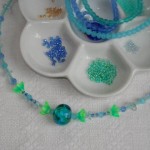
Finished strand of beads with loose seed beads
Here I have a blue green center bead I made with some companion beads – seed beads and some slightly larger beads for more color and contrast.
A variation on this would be to have three or more strands of smaller beads holding that larger center bead, the multi-strand necklace. Next time I will have a knit tube of seed beads forming the necklace to show off, stay tuned.
The new Aura Sun Arts glass studio is nearly ready for action.
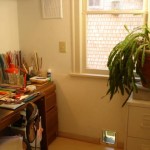
new studio in a sunny corner
I have the glass canes in easy reach, and ones in current use arrayed on a hotplate. A second hotplate on the left out of view keeps the finished beads warm as they slowly cool down, a process called annealing. The sunny window will give me plenty of ventilation, as will the fan. I still need a warm enough day to keep the glass happy.
Now that I am back in Seattle I will have to make a pilgrimage to the Tacoma Museum of Glass. I saw a delightful special on Evening Magazine featuring their exhibit of glass designed by children. 52 different fantastical sketches by children were made up into finished pieces by the glass professionals, who had a great deal of fun in the process.
The links above will show you a video and a slide show of some of the featured work. Here is a cucumber guy by kdg.

kdg-cucumber
How does one make a lampworked glass bead?
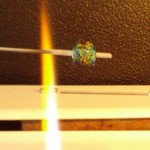
half made bead
Take a steel rod of 2 – 3 mm diameter, coated with a clay release agent, and heat up this rod in the flame. With the other hand, select a glass rod of the color needed, and introduce this slowly to the flame as well. The end of the glass rod will begin to melt, and form a blob, or “gather.” Drip this onto the rod, and wrap it around. Click on the photo for a larger view.
I usually marver the bead now, by rolling it on a flat surface until it takes a cylinder shape, and use this as my canvas to paint with more colors. I keep adding layers of color, and often finish the bead with some clear glass encasing.
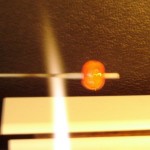
fully molten bead
The bead can be rather lumpy at this point, like a raspberry. I heat it up further until it is entirely molten, and takes on a smooth rounded shape. You must continually rotate the rod to keep the bead centered. If you wish the bead to be textured you skip this rounding. The bead can also be shaped by rolling it on a flat surface, or pressing it into a mold.
Then let it cool down until the normal colors return to the glass, and put it away in a kiln or warming thermal blanket to rest for several hours. The next day it can be taken off the rod: after a soak the clay rinses away and it twists free, the bead is complete and the rod can be re-coated with clay for the next dance.
The flame is a Minor lampworking torch with a mixture of propane and oxygen fuel. Proper ventilation and didymium safety glasses are essential. Wikipedia has several good entries relating to beadmaking and glass art.
Click on any photo here for a larger view.
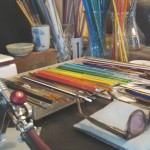
torch, glass rods, and safety glasses
Tags: beads, clay, color, didymium, encasing, glass, handmade, lampwork, marver, molten, thermal, torch
 AuraSunArts, making glass beads | mary |
AuraSunArts, making glass beads | mary |  July 18, 2010 3:09 pm |
July 18, 2010 3:09 pm |  Comments (0)
Comments (0)
I have a fascination with the electromagnetic spectrum.
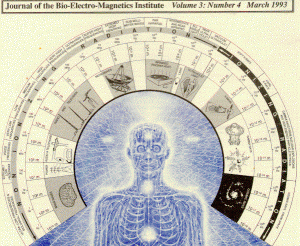
the electromagnetic spectrum
The rainbow shows a spectrum of light, the piano keyboard a spectrum of audio vibrations. It’s all the same energy, just vibrating at different speeds. Artists use color wheels to predict what colors will blend and complement. Musicians know the same relationships as chords.
Here’s the cover of the BEMI Journal showing the electromagnetic spectrum with inset illustration by the visionary artist Alex Grey, well known for his art depicting the human aura and anatomy. Brainwaves are way down at the slowest frequency. Click for a larger view.
Glass is technically not a solid, it is a super-cooled liquid. I like to think of human brainwaves as super-cooled light.
The BEMI Journal ceased publication years ago, but here is an article on Bioenergy Healing that references it. See my rainbow stripe beads for my salute to the visible spectrum.
Tags: aura, electromagnetic, energy, frequency, glass, light, rainbow, spectrum, wave
 electromagnetics, making glass beads | mary |
electromagnetics, making glass beads | mary |  July 11, 2010 6:30 pm |
July 11, 2010 6:30 pm |  Comments (0)
Comments (0)
I once had a butterfly stand,
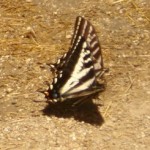
swallowtails
where I sold hand colored paper butterflies to my mother, who wisely thought that safer and more creative than a lemonade stand.
I suspect she still has those paper butterflies, carefully stored away.
Now I have the chance to try my hand at butterflies again, shaky childish efforts only a mother could love. Click to see them fly.
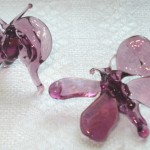
glass butterflies
Could this be an example of the mother-daughter butterfly effect?
Creating small sculptures in glass is an interesting challenge.
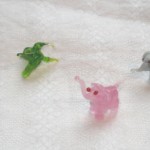
elephants and friends, click to see all
The molten glass is like taffy or honey and tends to leave strings of itself behind. You melt an initial blob to be the body, then dab on another blob at the hip, and watching carefully, pull slowly, drawing out a string of the proper thickness to form a leg, bending it into a leg shape, and then melt the excess away at the foot. Later as you are working on another leg, you must take care to not accidentally melt the first leg, or melt off the tail. It is wise to work on the biggest body parts first and leave the tiny extremities for the last.
Here are some of my baby steps in this arena; a black horse, a green hummingbird, and a trio of elephants. These are not for sale, they are just kindergarten doodles.
To see the work of master glass sculptor Pino Signoretto, and learn about his life, check out this in depth interview at the Nautica website.
“Furthermore, glass itself has something to do with the sea, in effect, to make the magic happen you need four ingredients: sand, water, air and fire, to which I would add a fifth element which is the physical energy which the artist needs to use to shape glass.” ~ Pino Signoretto
Tags: air, animal, element, fire, glass, molten, sand, sculpture, sea, water
 making glass beads, private reserve | mary |
making glass beads, private reserve | mary |  June 20, 2010 5:10 am |
June 20, 2010 5:10 am |  Comments (0)
Comments (0)
Having some copper wire on hand,
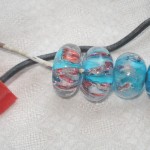
chunks of copper wire encased in glass
I thought to try incorporating some small chunks into some beads. Now if you are trying to melt copper, it is a cranky metal, and will just throw sparks as you pour on the heat with the torch, until it finally surrenders. It holds heat and conducts it, but doesn’t like to melt.
I expected the bits of copper wire to stick readily to the molten glass, but it was having none of it, only left a dent in the soft mass. Well, I flipped the bead dent side up and placed the chip of copper in the cavity with pliers and then sealed it in with clear glass encasing. Great fun! The bright copper looked fine against the turquoise glass. Turquoise and copper are mined together, a natural pair.
The molten glass behaved differently with the copper heat sink it contained, and I tried to let them cool extra slowly, but they still cracked. A grand experiment, nonetheless. Further trials with thinner gauge wire await. Click on the photo for an enlarged view.
Blue has to be one of my favorite colors.
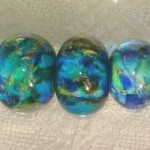
oceanic blues and greens
Blue glass beads can remind one of the fabulous colors of the ocean. Tropical waters are very clear, with little plankton, and the water is clear all the way down to the sandy bottom, showing off those gorgeous turquoise tints. Northern waters, with richer plankton, are a dark blue green.
When you paint with watercolors, you can combine or layer colors to blend and mix until you achieve new colors. Glass is much the same, so start with a sandy layer, then add pale blues and greens, deeper blues, some flotsam, jetsam, and a few bubbles, and you can almost imagine yourself snorkeling, rocking in the ocean to the sound of your breathing.
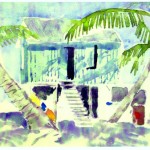
watercolor painted in Belize
Click on the photo to see more big blues. Those with a layer of clear glass on the outside – “encasing” – have an extra sense of depth. This layer refracts and bends light just as water does. Quite a few of these are matched pairs or sets. See all the blue beads on the Blue oceans page. Other new sets are featured on the Earrings page.
Tags: AuraSunArts, beads, blue, breathe, bubbles, color, depth, earrings, encasing, glass, gorgeous, ocean, paint, pair, refract, sand, turquoise, water, watercolors
 AuraSunArts, making glass beads | mary |
AuraSunArts, making glass beads | mary |  June 6, 2010 1:01 pm |
June 6, 2010 1:01 pm |  Comments (0)
Comments (0)
People are sometimes puzzled when they see my jewelry.

glass rods
You made the necklace, and the beads? The bead stringing they can understand, but they are sometimes shocked to hear that I made the beads themselves and ask how.
It all starts with glass rods and a torch. Here you see my work area with the many colors of glass rods arrayed on a hotplate. The red knob at lower left is part of the torch. At lower right you see the didymium safety glasses. Click on the photo to see a larger view.
Lampwork is the term used to describe working with molten glass using a small ‘lamp’ or torch. The beads are made by heating up the glass rods until liquid, and wrapping it around a steel rod coated with a release agent. After the bead is complete, the rod is removed and that leaves a hole in the bead.
Stay tuned for weekly posts about beadmaking, other artistic adventures, and the Friday Mo report!













